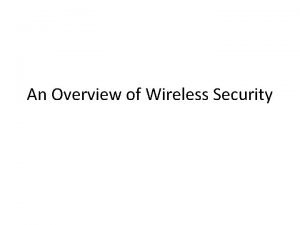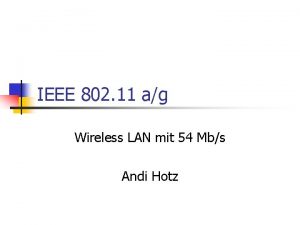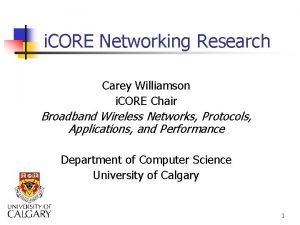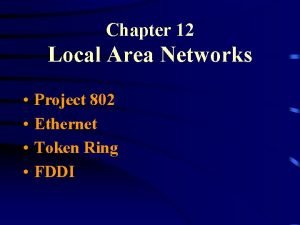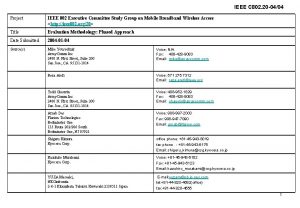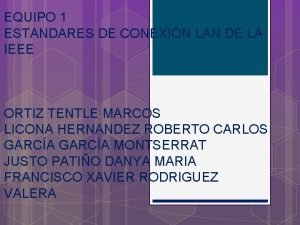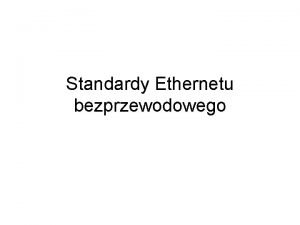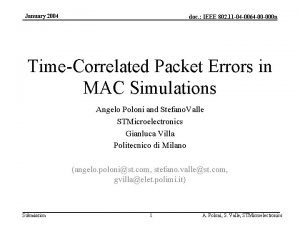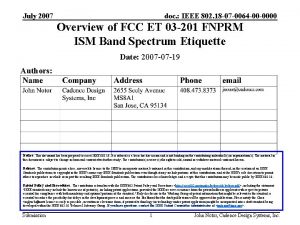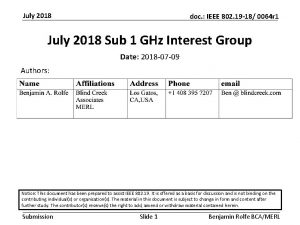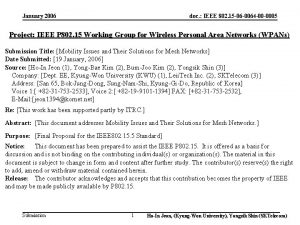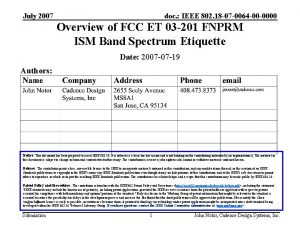omniran17 0064 01 CF 00 P 802 1








- Slides: 8

omniran-17 -0064 -01 -CF 00 P 802. 1 CF Information Model Structure Date: 2017 -09 -04 Authors: Name Affiliation Max Riegel Nokia Phone Email maximilian. riegel@nokia. com Notice: This document does not represent the agreed view of the IEEE 802. 1 Omni. RAN TG. It represents only the views of the participants listed in the ‘Authors: ’ field above. It is offered as a basis for discussion. It is not binding on the contributor, who reserve the right to add, amend or withdraw material contained herein. Copyright policy: The contributor is familiar with the IEEE-SA Copyright Policy <http: //standards. ieee. org/IPR/copyrightpolicy. html>. Patent policy: The contributor is familiar with the IEEE-SA Patent Policy and Procedures: <http: //standards. ieee. org/guides/bylaws/sect 6 -7. html#6> and <http: //standards. ieee. org/guides/opman/sect 6. html#6. 3>. Abstract The revision of the presentation provides an initial example of the basic structure of the P 802. 1 CF information model. 1

omniran-17 -0064 -01 -CF 00 P 802. 1 CF Information Model Structure Max Riegel (Nokia) 2017 -09 -04 2

omniran-17 -0064 -01 -CF 00 Information Model An information model* in software engineering is a representation of concepts and the relationships, constraints, rules, and operations to specify data semantics for a chosen domain of discourse. Typically it specifies relations between kinds of things, but may also include relations with individual things. It can provide sharable, stable, and organized structure of information requirements or knowledge for the domain context. Y. Tina Lee (1999). "Information modeling from design to implementation" National Institute of Standards and Technology. * On difference between Information Model and Data Model: RFC 3444; A. Pras , J. Schoenwaelder; IETF, 2003 3

omniran-17 -0064 -01 -CF 00 Purpose of P 802. 1 CF Information Model • Graphical representation of the configuration information and statistics of the IEEE 802 access network infrastructure and communication service. • Distinction and relationship between ‘network’ information and ‘service’ information – Structural description of network architecture. • Describe what the thing is – Description of parameters of user service • Describe what the thing delivers • Description of the structure of the management information and the control functions of IEEE 802 access network. 4

omniran-17 -0064 -01 -CF 00 Network management approaches FCAPS OAMPT • • Fault management – Detection, correction and logging of faults that occur in the network • Configuration management – Procedures used to control normal network operation • – Monitoring of system configuration information, and any changes of it • Accounting management Performance management • Security management – Controlling access to assets in the network Maintenance – Re-adjustments of system operation due to failures and regular needs • – Ensuring that network performance remains at acceptable levels • Administration – Support procedures accompanying normal network operation – Collection and tracking of network utilization information • Operation Provisioning – Installation and activation of new network resources. • Troubleshooting – Procedures due to fault or failure to compensate the misbehavior Neither approach can really be directly reflected in information model; OAMPT may be more suited for IEEE 802 access network. 5

omniran-17 -0064 -01 -CF 00 Thoughts on information model structure • Essentially two information models needed: – Network model – Service model • Network information model – Description of network infrastructure – Structured according to the functional entities of NRM – Differentiating configuration (wr) and statistics (ro) • User service information model – Abstract description of communication service • Description of user session • End-points, performance attributes, security aspects 6

omniran-17 -0064 -01 -CF 00 AN Information Model - a first attempt Access Network AN-ID 1 Access Network Control ANC-ID 1 Network Management Service NMS-ID 0+ Coordination and Information Service CIS-ID 1+ Subscription Service SS-ID Service Provider: FQDN 0+ Access Router AR-ID 1 Access Router Control ARC-ID 1+ Access Router Interface ARI-ID 1 Backhaul BH-ID 1+ Node of Attachment NA-ID 0+ Terminal TE-ID 1 Terminal Control TEC-ID 1+ Terminal Interface TEI-ID 7

omniran-17 -0064 -01 -CF 00 Conclusion • Does the first attempt make sense? • How to proceed? : – Definition of the graphical syntax (simplified UML) – Design of the information structure for ‘service’ – More comprehensive listing of attributes • Config attributes: ‘wr’ • Statistics attributes: ‘ro’ – Adding of methods to object classes • Methods denote functional procedures described in chapter 7 8


